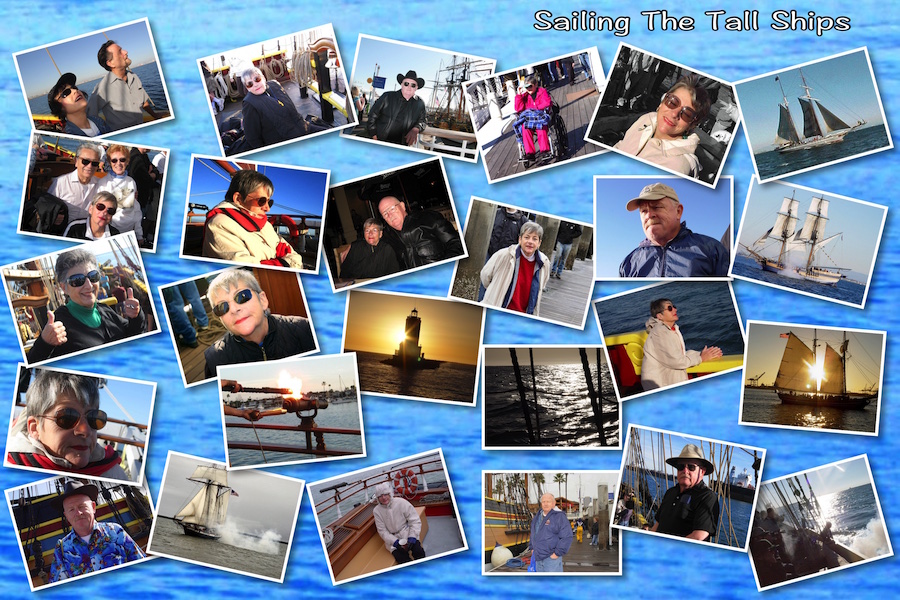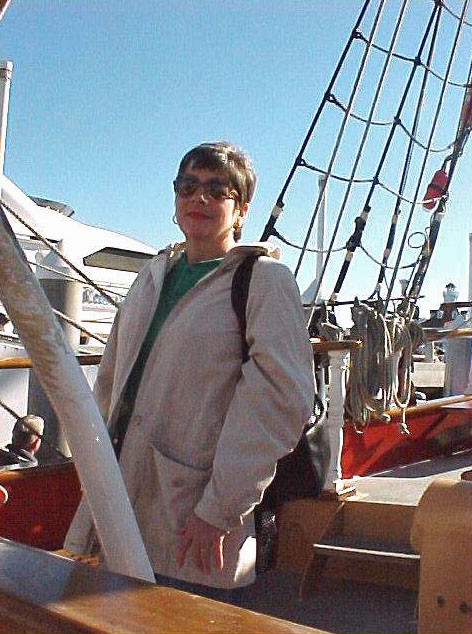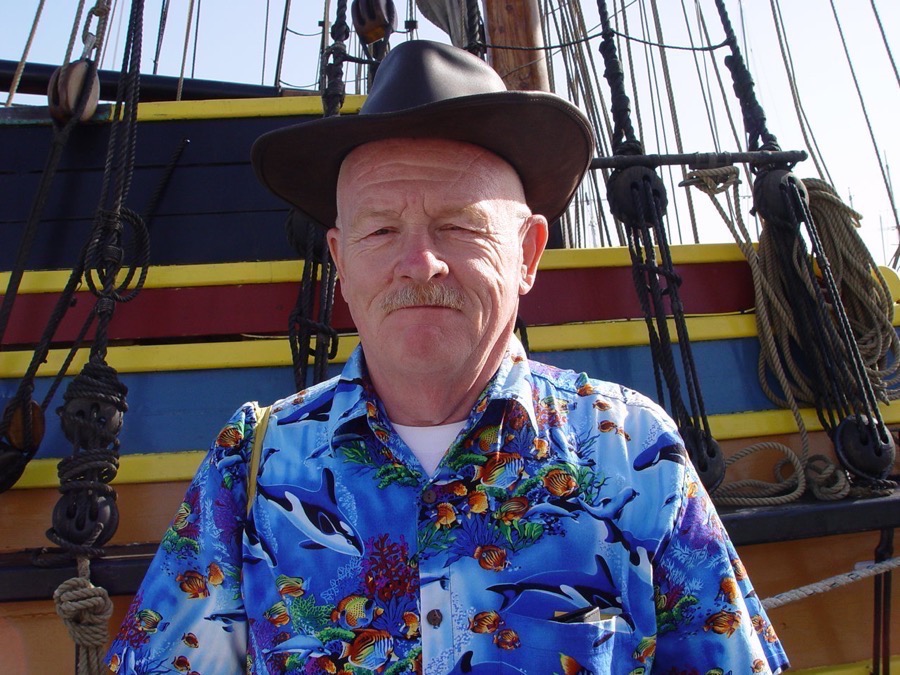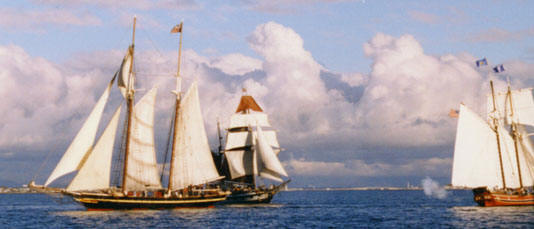The Tall Ships Are An Exciting Afternoon Adventure
We have gone to the Tall Ships in Long Beach Harbor for years and taken an afternoon ride and fought battles and "swashed buckles" with the buccaneers who pilot these vessels. Please join us for the fun.

Click for full-sized image (3600x2400)
Just Having Fun

Wind in our hair...... Well, Sue's anyway

We have enjoyed the Tall Ships for years! Sue was enjoying the wind
in her
hair and Paul was attempting to keep what little hair he has
on his head!
2000 (Details)
January 8th, 2000. The cannon fire was amazing... great 50 pound balls of steel sent flying for miles (not really). We got used to "Fire in the hole" and quickly covered our ears.!
Did You Know? - "Fire in the hole" is a warning that an explosive detonation in a confined space is imminent. It originated with miners, who needed to warn their fellows that a charge had been set.[1]
The first cannons developed were discharged, shot or exploded by placing a flaming torch to a small hole packed with gunpowder and leading to the main powder charge. This caused the main charge to explode, propelling the cannon ball to the enemy, or sometimes, blowing up the cannon and all standing nearby.
Hence, fire in the hole was both a command to the torch man, and a warning to all around. Over time cannons improved; they became safer, with no hole or fire needed. The command was reduced to fire, while the full phrase fire in the hole became a general warning for the use of explosive weapons. It was subsequently adopted by the United States Army and Marines to give notice that a grenade or satchel charge was being tossed into a bunker, spider hole, or other enclosure. The term frag out is also commonly used. It is not used for all explosions – throwing a grenade in the open is not announced, for example – only those surprisingly close.

"Fire in the hole"

This was a great ride. It was supposed to have rained but
instead it blew!! Sue's ears
are covered because of the great booms made by the ferocious cannon fire!
Note: We went in 2001, 2002, and 2003 but did not take pictures as the wheelchair did not lend itself to fighting with camera but we had loads of fun anyway! The pain shots are working and we have NOT had the back surgery yet ( November 3, 2003 ).
2004 (Details)
This was an amazing day on the ships.... 1/10/2004 and only a two months earlier Sue had her back surgery but we cold not keep her down! We CAREFULLY sent sailing on this blustery winter afternoon.
November 3, 2003 - Entered hospital for 7 hours surgery called Anterior fusion.
November 4, 2003 - ICU with a lot of pain.... no big surprise!
November 5, 2003 - Remains in ICU, coherent but sleepy
November 6, 2003 - Moved from ICU to Room 127A
November 7-9, 2003 - Recovery, clear fluids only! Gets up every day for a short assisted walk!
November 10, 2003, Posterior fusion accomplished during an 11 hour operation!
November 11, 2003 - ICU all day, awake and alert. Sits on side of bed for 45 minutes~
November 12, 2003 - Walks in ICU in the morning and moves to regular room in the afternoon. Walks a couple of hundred feet.
November 13, 2003 - Most of intravenous tubes removed.
November 17, 2003 - Home!

We had wind for this sailing adventure

The
year of recovery from back surgery and we went in the wheelchair with
great assist form the crew! It was a cold trip and it was supposed to
rain... The kids woosed out on us!
2005 (Details)
January 8th, 2005 and it was a very stormy weekend and rain and wind was predicted for this afternoon. We asked the kids and grand kids to join us but the "woosed out" so it was up to Paul & Sue to carry on the tradition... and we did! Super afternoon! no rain but plenty of wind power and we kept warm with layers of clothes and an occasional hug

Looking good!

The year of back recovery and she is moving quite sell. We sailed back and forth on the Hawaiian
Chieftain.
2006 (Details)
No battle on 1/14/2006 but the ride was worth the trip to San Pedro! We visited the Nautical Museum and was visited by the Coast Guard during the cruise. The Lady Washington sailed for three hours out amongst the supertankers and freighters of the 21st century! Cannons were a blazing and sea gulls were scared to death! Great crew and a great time was had by all! Afterwards we landed at Acapulco for a hot cup of coffee (for our hands) and a cold Marguerita for our... whatever!


An exciting battle was held at sea with our ship taking the prize
Did You Know? - The line of battle tactic that allowed efficient use of broadside fire was not put into general use until the late 17th century. The interim solution was to make sailing ships fire backwards from the stern, as a defensive measure, or forward from the bow, as an offensive measure. The latter was only partially achieved either by canting (angling) the side guns towards the bow or stern as far as the ship structure would allow, or to place guns on the sterncastle and fire them in an arc on either side of the forecastle. Both solutions were problematic since they created a blind spot dead ahead and made it especially difficult to hit low-lying targets, like galleys. The method that was deemed most effective by contemporaries was to simply counter the threat of galleys with other galleys.
Despite the technical innovations, naval cannon gunfire also remained grossly inaccurate except at very close ranges. Difficulties in achieving standardization in metallurgy meant that all guns allowed for considerable "windage", meaning that bore diameters were about 10 percent larger than the ammunition. Combined with inefficient gunpowder and the difficulties inherent in firing accurately from moving platforms meant that naval tactics for sailing ships throughout the 16th century remained focused on boarding as a means of decisive victory.
Naval tactics in the Age of Sail were primarily determined by the sailing and fighting qualities of the sailing warships of the time. Three factors, in particular, constrained what a sailing admiral could order his fleet to do.
2007 (Details)
January 13th was darned right chilly but we were prepared having done this before many time!


An exciting year.... No wheelchair so Sue is getting ready to climb the ropes and go into the sails to assist the crew!
Did You Know? - The evolution of broadside cannon during the first half of the 17th century soon led to the conclusion that the fleet had to fight in a single line to make the maximum use of its firepower without one ship getting in the way of another.
The line of battle is traditionally attributed to the navy of the Commonwealth of England and especially to General at Sea Robert Blake who wrote the Sailing and Fighting Instructions of 1653. The first documented deliberate use seems to be somewhat earlier in the Action of 18 September 1639 by Dutch Lieutenant-Admiral Maarten Tromp against the Spanish. The tactic was used by both sides in the Anglo-Dutch Wars, and was codified in written 'fighting instructions'. These formed the basis of the whole tactical system of the 17th and 18th centuries in naval warfare.
2009 With Nancy And Vince In Long Beach


2010 It Was Us And Newport Harbor (Details)

A magnificent day for a battle (against ourselves...Only one ship today)
2012 With Pete And Lisa Chartier (Details)

Another great sail up and down Newport Harbor

The Lady Washington fighting a brave battle.
January 5th, 2013 (Details)
December 29th 2013 We Are Sailing Again (Details)
What Is A "Tall Ship"
A tall ship is a large traditionally rigged sailing vessel.
Popular modern tall ship rigs include topsail schooners, brigantines, brigs and
baroques.
Traditional rigging may include square rigs and gaff rigs, with separate topmasts and topsails.
It is generally more complex than modern rigging, which utilizes newer materials such as aluminum and steel to construct taller, lightweight masts with fewer, more versatile sails.
The term tall ship has come into widespread use in the mid-20th century
with the advent of The Tall Ships' Races.
Don't Call Them Ropes And Sails; It's Rigging
Rigging is the mechanical sailing apparatus attached to the hull in order to move the boat as a whole.
This includes cordage (ropes attached to the spars and sails in order to manipulate their position and shape), sails (aerofoils, usually made of fabric, used to catch the wind), and spars (masts and other solid objects sails are attached to).
Cordage is more usually the term for stocks of rope, yarn, or other types line in storage, before it has been put to some use in a vessel, where after is commonly referred to as the rigging.
In this article, Rigging denotes
the full set of cordage, sails and spars, except when it is part of
another term (see running rigging and standing rigging).
Certain sail-plans are utilized for certain purposes according to their
aerodynamic properties.
All sailing vessels are classified according to their hull design and rigging.
The Ships
Visit the ships we have visited and see them up close and in action in the Long Beach Harbor.

In San Pedro we got to see the trolley

